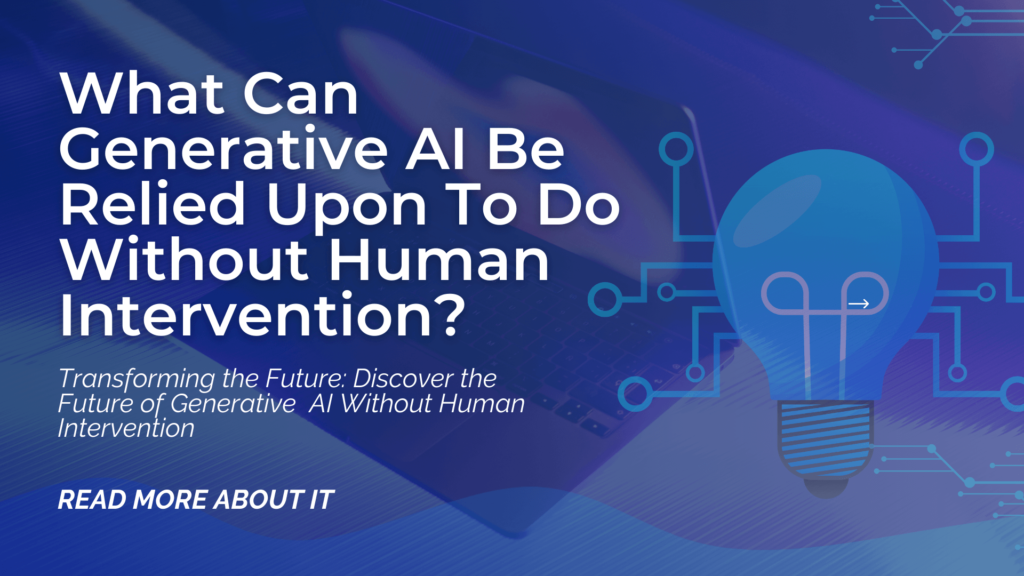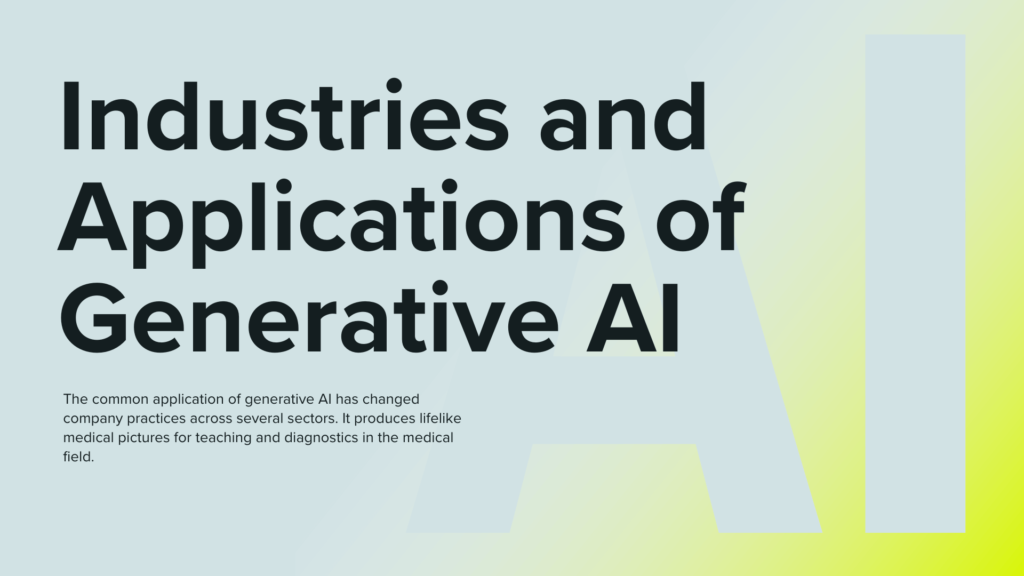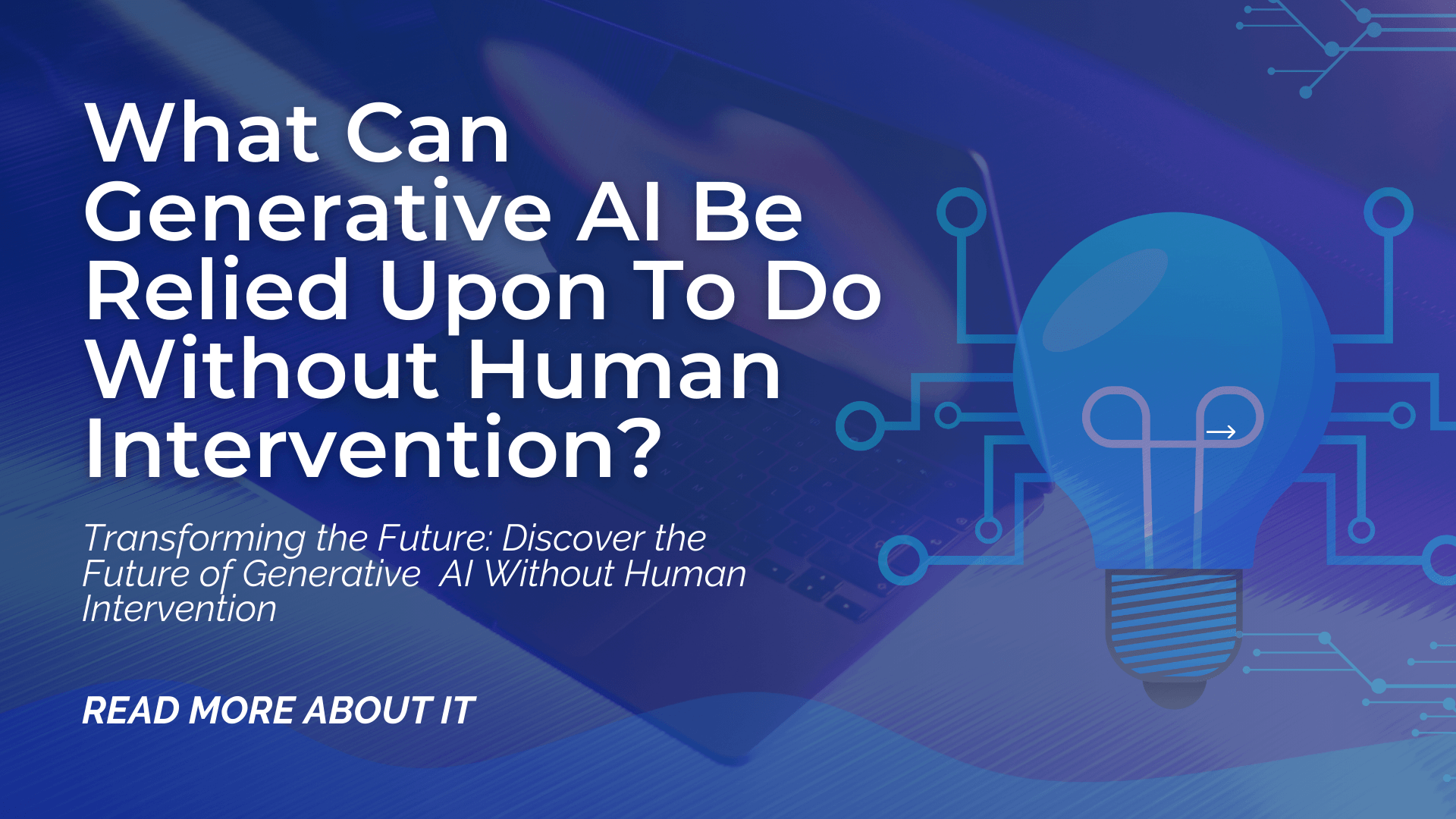
From what generative AI can we rely upon to do without human help?
The generative AI field is changing how we think about and use technology. Imagine a future where computers can write stories, make music, and draw pictures autonomously. The remarkable progress made in AI in recent years has resulted in an upsurge of interest across many sectors.
Generative AI will create drafts, answer straightforward questions, arrange data, generate text, and come up with new designs all by itself, without human intervention. Because it’s able to work independently, generative AI is revolutionizing numerous industries. Making content is one of its primary uses.
However, what can generative AI be relied upon to do without human intervention? As we explore the possibilities and uses of generative AI, you will learn about its potential and the difficulties it presents.
Generative AI can be relied upon to perform several tasks without human supervision, including:
- Generating text
- Generating code
- Creating new designs
- Creating images and graphics
- Composing music
Introduction to Generative AI
Generative AI is an essential subfield of AI that aims to generate original material. Generic models can create new media, such as text, photos, music, and videos, unlike conventional AI, which primarily sorts or analyzes data. Algorithms for pattern recognition from preexisting datasets are fundamental to this technology. Recognizing these patterns creates something completely new that is reminiscent of human inventiveness.
The list of possible uses is long and varied, including fields as disparate as painting and storytelling. Generative AI keeps pushing the envelope of creativity thanks to developments in machine learning techniques such as neural networks and deep learning.
In today’s rapidly evolving digital landscape, generative AI is becoming increasingly important. It forces us to reevaluate our definition of creativity while revealing previously unexplored paths for innovation. As we investigate what machines can produce independently, the possibilities appear limitless.
The Capabilities of Generative AI
Generative AI has been a game-changer when it comes to brainstorming and solving problems. This system uses massive databases to generate material with human-level comprehension, automatically creating text, graphics, audio, and videos and requiring minimal human intervention.
Among its notable features is the ability to process natural language. Content creators seeking to increase productivity will find generative AI helpful because it can construct articles or tales coherently.
In the artistic world, algorithms turn ideas into works of art. They analyze current trends and create fresh, emotionally engaging art. It also helps with software development by producing code snippets according to user input. This feature makes development processes more efficient and shortens project schedules.
Businesses are finding creative uses for generative AI in various industries as they delve further into these capabilities. As this technology keeps developing at a breakneck speed, the possible uses appear endless.
Basic Tasks Generative AI Can Handle
Generative AI is changing how we do things we do every day. It is good at automating routine tasks, which allows humans to focus on more complicated projects. Generative AI really comes into its own when it comes to content production. This technology can generate captivating material in seconds, be it articles or social media updates.
Another area that benefits from its skills is customer service. Chatbots driven by generative AI can work around the clock to improve the user experience and respond instantly to requests.
Another critical task is analyzing data. Finding patterns and insights in massive datasets could take people weeks, but generative AI algorithms can do it in minutes. Imaginative domains are also not untouched. Generative AI offers tools for visual creation, music composition, and more, inspiring creativity and optimizing workflows. These simple exercises demonstrate the limited capabilities of generative AI in today’s dynamic reality.
Data Processing and Organization
Generative AI excels in data processing and organization. It can process the same mountain of data in a fraction of the time it would take a human to find patterns. This feature is crucial for companies working with massive amounts of data. Generative AI allows for effectively classifying and sorting data, be it customer information or sales figures. By automating these tasks, companies may let workers devote more time to strategy and creativity.
Data management precision is further improved using generative AI. There is a far lower chance of human mistakes with automated systems compared to manual entry jobs.
Improving its organizational skills is a continuous process, made possible by its ability to learn from current datasets. This scalability ensures that data is relevant and organized even when more data comes in without requiring constant human intervention.
Ethical Considerations for Dependence on Generative AI
As generative AI becomes more popular, it brings up a lot of challenging social issues. Concerns of responsibility arise as our dependence on these sophisticated systems grows. When an AI makes false or damaging statements, who is to blame?
Another factor to consider is intellectual property. Ownership becomes more complicated when AI produces artistic works. Who initiates the algorithm’s execution, its maker or the user?
On top of that, training data could be biased. The output could reinforce prejudice and false beliefs if the datasets used to train them reflect societal biases. Algorithms frequently need to provide the necessary transparency. Decision-making procedures must be made very clear for these technologies to earn users’ trust. The long-term use of generative AI can reduce the human capacity for original thought and analysis.

Industries and Applications of Generative AI
The common application of generative AI has changed company practices across several sectors. It produces lifelike medical pictures for teaching and diagnostics in the medical field. Thanks to this technology, analyses are more reliable, and new discoveries are made more quickly.
Generative AI has also found a home in the entertainment industry. It can write screenplays, music, and virtual worlds that players can sink their teeth into. Algorithms and artists work together to create new heights of creativity.
Furthermore, generative AI is useful in marketing. Using it, brands can mass-customize content and create advertising that speaks directly to each customer. This method improves efficiency without sacrificing engagement.
Financial institutions can benefit from AI-generated predictive models for risk evaluation and fraud detection tasks. These programs can process massive datasets far more quickly than people can. Generative AI is revolutionizing several industries, from architecture to fashion design.
Examples of Successful Applications
Generative AI has made effects across different sectors, displaying its incredible flexibility. In art, algorithms like DALL-E create magnificent visual creations based on verbal descriptions. Artists and designers utilize this technology to spark inspiration or produce distinctive creations.
In content production, technologies like GPT-3 can compose articles, generate marketing material, and even prepare emails with minimal human involvement. Businesses employ these skills to streamline operations and boost efficiency. The gaming industry also sees considerable benefits from generative AI. It generates realistic environments and characters in real time, offering immersive experiences for players.
Furthermore, in pharmaceuticals, generative models assist scientists in discovering new medication molecules faster than standard approaches allow. This accelerates research timeframes and effectively brings possible therapies to market. These examples highlight how generative AI revolutionizes businesses by automating challenging activities while fueling creativity and innovation.
Benefits and Limitations of Using Generative AI
Generative AI delivers significant benefits that can alter industries. Its capacity to develop material rapidly and efficiently saves time and resources. Businesses can exploit this technology for tasks such as generating reports, making marketing materials, or authoring code.
There are limits to relying on generative AI, though. The algorithms and input data employed determine the output quality. There are instances when the produced material is shallow and lacks the subtlety of human-made works.
Additionally, although automation increases output, it can diminish employment prospects in some industries. This strains the relationship between efficiency gains and the effects on the workforce. Enterprises must have a deep understanding of these processes to successfully incorporate generative AI into their operations. By balancing its possible downsides with its benefits, you can enhance value while limiting risks.
Potential Risks and Limitations
Generative AI has incredible potential but has certain limitations and concerns that should be addressed. The reliability of computer-generated material is an issue. Due to the prevalence of errors or incorrect information, disinformation is easy to spread.
Data security also poses a substantial danger. Many generative AI systems depend on massive datasets that can include confidential or secret information. Poor management can lead to accidental data leaks.
Another critical problem is bias. If generative models are trained on biased perspectives, they risk reinforcing damaging stereotypes. Furthermore, it needs more emotional intelligence to manage complex human interactions successfully. When used in customer service or other delicate fields, this might lead to misconceptions. Concerns regarding responsibility and management of automated procedures may arise if businesses continue to rely on this technology without adequate supervision.
The Future of Generative AI
Generative AI has a bright future ahead of it. As technology progresses, we can anticipate ever-more-advanced models that challenge norms of creativity. Envision artificial intelligence systems that can create photorealistic artwork, compose works of art indistinguishable from those written by humans, or even write books. A world of fascinating and limitless possibilities awaits.
Workflows will also be rethought as generative AI becomes more widely used across industries. Efficiency increases can potentially revolutionize various sectors, including healthcare diagnostics and tailored marketing. The necessity for appropriate use, however, grows in tandem with the possibilities. The key to influencing this future landscape is balancing innovation and ethical concerns.
If people and machines work together, revolutionary progress could be achieved. By combining the best features of both groups, we can overcome insurmountable obstacles and unleash unprecedented innovation.
Future Possibilities and Potential Challenges
Exciting opportunities await generative AI in the future. We may anticipate more innovation and productivity across many domains as technology advances. Innovative, previously unthinkable solutions will most certainly be generated by these systems in the fields of art and medicine.
This quick growth has its challenges, though. The preservation of originality while ensuring ethical use is of utmost concern. Concerns around attribution are likely to emerge as generative AI produces virtually indistinguishable content from humans.
Furthermore, there is a significant risk of abuse. Without effective management, the spread of deep fakes and disinformation could worsen. The more we depend on these technologies, the more critical it is to establish strong accountability structures.
How well we manage innovation and accountability will determine the future of generative AI and its societal impact. To promote public confidence in new technology, stakeholders must work together to navigate this complicated terrain successfully.
Conclusion: What Can Generative AI Be Relied Upon to Do Without Human Intervention?
From the creative and entertainment industries to the medical and financial sectors, generative AI is making its mark in many fields. Curiousness and apprehension surround its potential to generate material on its own. Grasping the capabilities of this technology is becoming increasingly important as organizations seek to utilize it for innovation and efficiency.
Because of its versatility and ability to work independently, generative AI is revolutionizing numerous industries. One of its most prominent uses is creating content. Without human intervention, it can produce articles, blogs, and even poetry.
Although generative AI holds much promise, we must not overlook its dangers and ethical concerns. How well we incorporate this potent instrument into our lives will depend on how well we balance its advantages with ethical use.
Generative AI holds great potential for future progress, but there are still obstacles. As we progress into a world influenced by AI, it will be crucial to monitor these changes. It already affects creativity, productivity, and decision-making in innumerable industries, and its influence on everyday operations will only grow.
Staying informed on the implications of generative AI is crucial for responsibly harnessing its powers and preparing for what lies ahead in this exciting intersection of technology and human endeavor. Our reliance on this technology is growing, so it’s essential to be ready.

